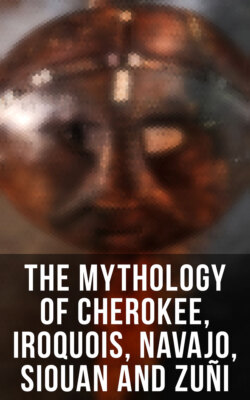Читать книгу The Mythology of Cherokee, Iroquois, Navajo, Siouan and Zuñi - James Mooney - Страница 238
На сайте Литреса книга снята с продажи.
The Magic Feather
ОглавлениеThe chief bulls were still angry, however, and determined that they would kill him, even though he had passed their tests. So they made him sit on the ground, all the strongest and fiercest bulls round him. Together they rushed at him, and in a little while his feather was seen floating in the air. The chief bulls called on the others to stop, for they were sure that he must be trampled to pieces by this time. But when they drew back there sat the Indian in the centre of the circle, with his feather in his hair.
It was, in fact, his magic feather to which he owed his escape, and a second rush which the buffaloes made had as little effect on him. Seeing that he was possessed of magical powers, the buffaloes made the best of matters and welcomed him into their camp, on condition that he would bring them gifts from his tribe. This he agreed to do.
When the Indian returned with his wife and son to the village people they found that there was no food to be had; but the buffalo-wife produced some meat from under her robe, and they ate of it. Afterward they went back to the herd with gifts, which pleased the buffaloes greatly. The chief bulls, knowing that the people were in want of food, offered to return with the hunter. His son, who also wished to return, arranged to accompany the herd in the form of a buffalo, while his parents went ahead in human shape. The father warned the people that they must not kill his son when they went to hunt buffaloes, for, he said, the yellow calf would always return leading more buffaloes.
By and by the child came to his father saying that he would no more visit the camp in the form of a boy, as he was about to lead the herd eastward. Ere he went he told his father that when the hunters sought the chase they should kill the yellow calf and sacrifice it to Atius Tiráwa, tan its hide, and wrap in the skin an ear of corn and other sacred things. Every year they should look out for another yellow calf, sacrifice it, and keep a piece of its fat to add to the bundle. Then when food was scarce and famine threatened the tribe the chiefs should gather in council and pay a friendly visit to the young buffalo, and he would tell Tiráwa of their need, so that another yellow calf might be sent to lead the herd to the people.
When he had said this the boy left the camp. All was done as he had ordered. Food became plentiful, and the father became a chief, greatly respected by his people. His buffalo-wife, however, he almost forgot, and one night she vanished. So distressed was the chief, and so remorseful for his neglect of her, that he never recovered, but withered away and died. But the sacred bundle was long preserved in the tribe as a magic charm to bring the buffalo.
Their sacred bundles were most precious to the Indians, and were guarded religiously. In times of famine they were opened by the priests with much ceremony. The above story is given to explain the origin of that belonging to the Pawnee tribe.
